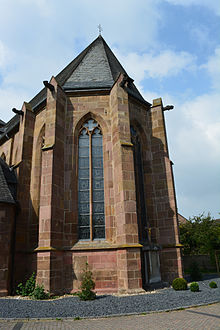St. Heribert (Kreuzau)
St. Heribert is the Roman Catholic parish church of Kreuzau in the Düren district ( North Rhine-Westphalia ).
The church is dedicated to St. Heribert von Köln and entered under number 25 in the list of architectural monuments in Kreuzau .
history
General
On April 14, 1303, a church in Kreuzau was first mentioned in a document. At that time the place was already an independent parish . The parish was also mentioned in the Liber valoris from around 1308. Presumably there was a church in Kreuzau much earlier. It is assumed that a chapel or church existed in the village as early as the 8th century, i.e. at the time of Charlemagne . Until the second half of the 16th century Niederau belonged to the Kreuzau parish as a branch. Until 1804, the parish still included the Untermaubach , Obermaubach , Bogheim , Langenbroich and Bilstein branches . As the last remaining branch communities of Kreuzau, Winden and Bergheim were separated in 1866 and raised to the parish of St. Urbanus, Winden.
Until the 16th century the church was consecrated to the Holy Cross . It was not until 1635 that St. Heribert von Cologne as patron of the church and parish.
Today the Kreuzau parish is part of the community of parishes (GdG) Kreuzau-Hürtgenwald .
Church building
The oldest part of today's parish church are the three lower floors of the bell tower . They are very likely from the 12th century. This tower was part of a single-nave Romanesque hall church . Around 1300 the Romanesque choir was abandoned and replaced by a Gothic one, which is still preserved today. Around 1350, the Romanesque nave was finally replaced by today's Gothic central nave and the southern aisle. Thus a two-aisled facility was created. In the 15th century, the tower got its present shape by adding the fourth floor.
In the 1860s, the building became so dilapidated that in the meantime a complete demolition and subsequent construction in the neo-Romanesque style was considered, whereby the increased population also played a role. In 1868 the Cologne architect Heinrich Wiethase was commissioned to draw up an expert opinion on the structural condition of the church and to draw up a concept for a possible renovation of the existing building. In the years 1869 to 1872 the church was finally renovated and rebuilt. The south aisle was torn down and replaced by a neo-Gothic one, which, however, was adapted to the structures of the Gothic choir and the central nave. In addition, the wooden barrel vault in the central nave was replaced by a stone ribbed vault . Between 1906 and 1907 the church was rebuilt again. She received the north aisle. In addition, the southern one was extended to the west by two bays so that it encloses the tower.
During the Second World War , the spire was destroyed and initially replaced by a much flatter pyramid roof. The old spire was not reconstructed until later.
architecture
St. Heribert is a three-aisled basilica in the Gothic style of the 12th to 20th centuries with an east-west orientation. In the west is the four-storey bell tower with the main portal in the basement. The three-aisled nave is attached to it . Two yokes of the side aisles are attached to the north and south sides of the tower. Between the choir and the south aisle, and between the choir and the north aisle, there is a sacristy and an ancillary sacristy. The entire church building is vaulted with cross ribbed vaults.
Furnishing
In the interior there is a stone, Gothic wall tabernacle and stained glass window from 1951.
organ
The organ is the work of organ builder Hans Klais, Johannes Klais Orgelbau company from Bonn (Opus 1023). It was made in 1952 and has 20 stops divided between two manuals and a pedal . The disposition is:
|
|
|
||||||||||||||||||||||||||||||||||||||||||||||||||||||||||||||||||
- Coupling : II / I, I-II Sub, IP, II-P
- Playing aids : hand register, two free combinations, tutti, register swell
Bells
|
No. |
Surname |
Diameter (mm) |
Mass (kg, approx.) |
Percussive ( HT - 1 / 16 ) |
Caster |
Casting year |
| 1 | Pius | 1,270 | 1,220 | dis ' + -0 | Wolfgang Hausen-Mabilon; Mabilon & Co. , Saarburg | 1956 |
| 2 | Heribertus | 1,064 | 650 | f sharp ' +4 | Conrad de Isbroich | 1362 |
| 3 | Holy cross | 950 | 480 | g sharp ' + -0 | Wolfgang Hausen-Mabilon; Mabilon & Co., Saarburg | 1956 |
| 4th | Kill | 955 | 550 | ais ' -3 | Conrad de Isbroich | 1362 |
Motive: O Savior, tear open the heavens
Web links
Individual evidence
- ↑ Parish and Parish Church Kreuzau (PDF), pp. 1–3.
- ↑ Parish and Parish Church Kreuzau (PDF), pp. 6–12.
- ↑ Internet site for church music in the Düren region, here St. Heribert organ, Kreuzau, 25 September 2015
- ↑ Norbert Jachtmann: Glockenmusik in der Düren region, p. 183 f.
Coordinates: 50 ° 44 ′ 53.2 " N , 6 ° 29 ′ 8.3" E

